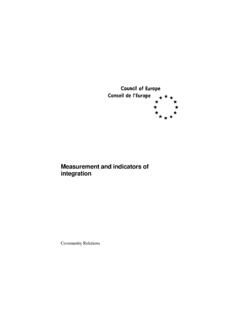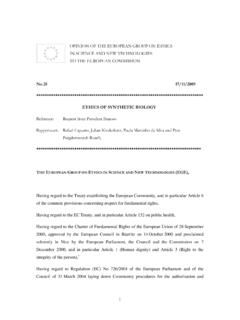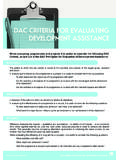Transcription of THE COSTS AND BENEFITS OF DIVERSITY
1 THE COSTS ANDTHE COSTS ANDBENEFITS OF DIVERSITYBENEFITS OF DIVERSITYF undamental rights & anti-discriminationEuropean Commission2 Emplo3yment social affairsTHE COSTS AND BENEFITS OFTHE COSTS AND BENEFITS OFDIVERSITYDIVERSITYA Study on Methods and IndicatorsA Study on Methods and Indicatorsto Measure the Cost-Effectivenessto Measure the Cost-Effectivenessof DIVERSITY Policies in Enterprisesof DIVERSITY Policies in EnterprisesFundamental rights and anti-discriminationEuropean CommissionDirectorate-General for Employment, Industrial Relationsand Social AffairsUnit D/3 Manuscript completed in October 2003 Executive SummaryExecutive Summary2 This report has been drawn up by the Centre for Strategy and Evaluation Service (CSES) on behalf ofthe European Commission, with support from the European Community action programme to for Strategy and Evaluation ServicesPO Box 159 Kent TN14 5 WTUnited KingdomThe full text of the report is available on-line at.
2 Contents of this publication do not necessarily reflect the opinion or position of theEuropean Commission3 OVERVIEWThis study examines the measurement of the COSTS and BENEFITS of workforcediversity policies, voluntary initiatives by businesses to recruit, retain, anddevelop employees from diverse social groups. The work has beenundertaken against a background of the implementation of new anti-discrimination directives throughout the EU and increased investment inworkforce DIVERSITY policies by sources of evidence have been used to complete the study, includinga survey of 200 companies in four EU countries; extensive literature reviews;development of 8 case studies of DIVERSITY promotion programmes in 6 Member States.
3 And 48 interviews with companies, business organisations,national governments, equality agencies, trade unions, and findings provide important insights into DIVERSITY policies and theirmeasurement that are of relevance to business managers, social partners,and , the report identifies a number of key that implement workforce DIVERSITY policies identifyimportant BENEFITS that strengthen long-term competitiveness and, incertain instances, also produce short and medium-term improvementsin performance (Exhibit A).
4 Exhibit ACompanies with Active DIVERSITY PoliciesBenefits Gained020406080Im proved global m anagem ent capacityAvoided litigation costsImproved access to new market segmentsLowered absenteeism ratesReduced labour turnoverHelped to overcom e labour shortagesEnhanced service levels and customer satisfactionIm proved innovation and creativity am ongs t em ployeesIm proved m otivation and efficie ncy of existing staffHelped to attract and retain highly talented peopleEnhanced corporate reputationStrengthened cultural values w ithin the organisation% of companies identifying benefit as important or very importantBase: Companies with active DIVERSITY policiesSource: CSES Survey of Companies4 Our evidence suggests that the most important BENEFITS arising from theimplementation of DIVERSITY policies arise from strengthening organisationaland human capital.
5 Along with knowledge capital, these are the principalintangible assets used by companies in a wide range of sectors to establishcompetitive advantage and to create are, of course, COSTS associated with the implementation of diversitypolicies. These include the cash COSTS of compliance with laws ondiscrimination and of the implementation of programmes to change internalcultures such that a diverse workforce is recruited, retained, and , there are also opportunity COSTS associated with the diversion ofmanagement time, and the execution risks associated with majororganisational change.
6 Systematic measurement of the COSTS and BENEFITS ofworkforce DIVERSITY policies is essential to sustain existing programmesand to build the business case for greater investment, especially by non-users .Leading companies measure the COSTS and BENEFITS of investments inworkforce DIVERSITY policies for a number of reasons: first, there is a tendencyfor measurement to drive action what gets measured gets done ; second,good practice requires the measurement of the COSTS and BENEFITS of all formsof investment, including investments in intangibles; third, measurementprovides a justification for the continuing use of scarce resources.
7 And, finally,measurement enables managers to learn lessons for future, are already a large number of indicators of cost and benefit in use bycompanies. Most of these are qualitative and tend to focus on COSTS and intermediate outcomes , such as changes in workforce attitudes ordemographics. As yet, there is little evidence of quantitative assessment ofcosts or BENEFITS . There is also little evidence of any systematic measurementof COSTS , BENEFITS and intermediate these problems with measurement, it is possible to constructa framework for performance measurement that provides a systematicmethod of identifying COSTS , BENEFITS , key processes, and model approach is based on existing measurement practices, evidenceof COSTS and BENEFITS , and modern performance measurement methods.
8 Ithighlights the value of measuring investments in DIVERSITY programmes, makesa clear distinction between inputs and different types of outcome, and forcescompanies to consider carefully different types of benefit and how to measurethem. Companies of all types and sizes can adopt this framework. Within acommon structure, the specific indicators and methods of measurement canbe tailored to meet the needs of each business (Exhibit B).5 Exhibit BSource: complex group of obstacles limit the scale of investment indiversity policies amongst companies in the EU.
9 These include legalrestrictions on the holding and processing of sensitive data; differencesin national cultural responses to different social groups; difficulties inchanging the culture of businesses; a lack of awareness amongstcompanies of the contents, BENEFITS , mechanisms, and rationale ofdiversity policies. Public policy has an important role to play in helpingto overcome some of the from our pilot survey of companies suggests that there are twomajor internal obstacles that limit investments in workforce DIVERSITY are difficulties in changing the culture of a business and a lack ofawareness of workforce DIVERSITY policies.
10 This awareness gap includes lackof knowledge about the content, rationale, COSTS , BENEFITS , and methods ofmeasurement of workforce DIVERSITY policies. There is considerable scope touse public resources to help overcome these deficiencies in contrast, the scope for public policy to help companies implement culturalchange programmes effectively is limited. The main problems facingcompanies are a lack of management expertise and a fear of change amongstworkers and Measurement Framework for DiversityShort/Medium Term Performance ImprovementBusiness BenefitsLong Term Improvements in Underlying Value Drivers Overall Business Performance DIVERSITY Outcomes Culture and Working EnvironmentDemographicsProgramme ImplementationBENEFITSCOSTS6 Our limited review of the socio-legal environment in the EU suggests thatthere may well be external obstacles to the













